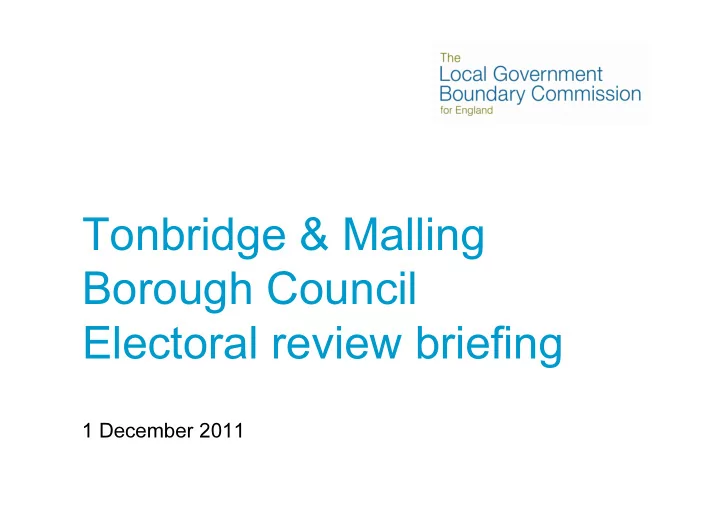

Tonbridge & Malling Borough Council Electoral review briefing 1 December 2011
Introductions • Joan D’souza – Review Manager 2
• An independent body set up by Parliament in April About us 2010 by the Local Democracy, Economic Development and Construction Act 2009 • We are independent of Government and political parties, and directly accountable to Parliament through the Speaker’s Committee • We are responsible for reviewing local authority electoral arrangements, administrative boundaries and structure • Our recommendations for this review will be implemented by Parliament 3
• Our aim is to try to ensure that each councillor represents approximately the same number of electors Why are we • Our criteria for starting an electoral review is conducting an where: electoral review – 30% of wards have an electoral variance of more than 10% from the average and / of Tonbridge & or Malling? – one ward has an electoral variance more than 30% from the average • In Tonbridge & Malling one ward has an electoral variance of more than 30% from the average – Kings Hill (43%) and 38% or wards have an electoral variance of more than 10% from the average 4
Map of This image cannot currently be displayed. wards and electoral variances in Tonbridge & Malling
• Review will decide the pattern of wards for Scope of the entire borough – not just wards where the review there are levels of electoral inequality • We will decide: – Total number of councillors (council size) – Number of wards – Names of wards – Boundaries of all wards 6
• Commission will take decisions on the Statutory basis of statutory criteria: Criteria - To deliver electoral equality for voters - To provide boundaries that reflect natural communities - To promote effective and convenient local government 7
• Parliamentary constituency boundaries, which are What we drawn by the Boundary Commission for England cannot consider • Current district wards • Local political implications of recommendations • School catchment areas • Postcodes or addresses • Polling districts 8
Review Pre- Review Stage process Preliminary stage: 6 – 8 weeks (starts November 2011) Issues to be determined during this stage: – View taken on council size – Determination of review ‘type’ 9
• No view on whether there should be an increase, Council size: reduction or no change The • Commission needs a good rationale for what is Commission’s proposed particularly in those areas where a substantial change is proposed approach • Commission will test rationale and underpinning assumptions 10
Depending on outcomes of preliminary stage, Commission will then determine type of review for Types of Tonbridge and Malling: Review • No expectation of change in council size: Typical length: 26-30 weeks • Expectation that any change in council size will be small: Typical length: 42-50 weeks • Expectation that a change in council size could be substantial: Typical length: 52-62 weeks 11
• Six week consultation on council size if preliminary stage proposes significant change. • Further information gathering (10 weeks) Review – Invite warding patterns from council, public, resident associations, everybody who takes an interest process – Welcome proposals for whole borough or a certain area – Commission tours area • Commission publishes draft recommendations – Posters provided to council to publicise review • Open consultation on draft recommendations (10 – 12 weeks) • Commission publishes final recommendations • Final recommendations will be implemented by order in the Houses of Parliament 12
Contact details • Review Manager: Joan D’souza email: joan.dsouza@lgbce.org.uk Tel: 020 7664 8531 13
Recommend
More recommend